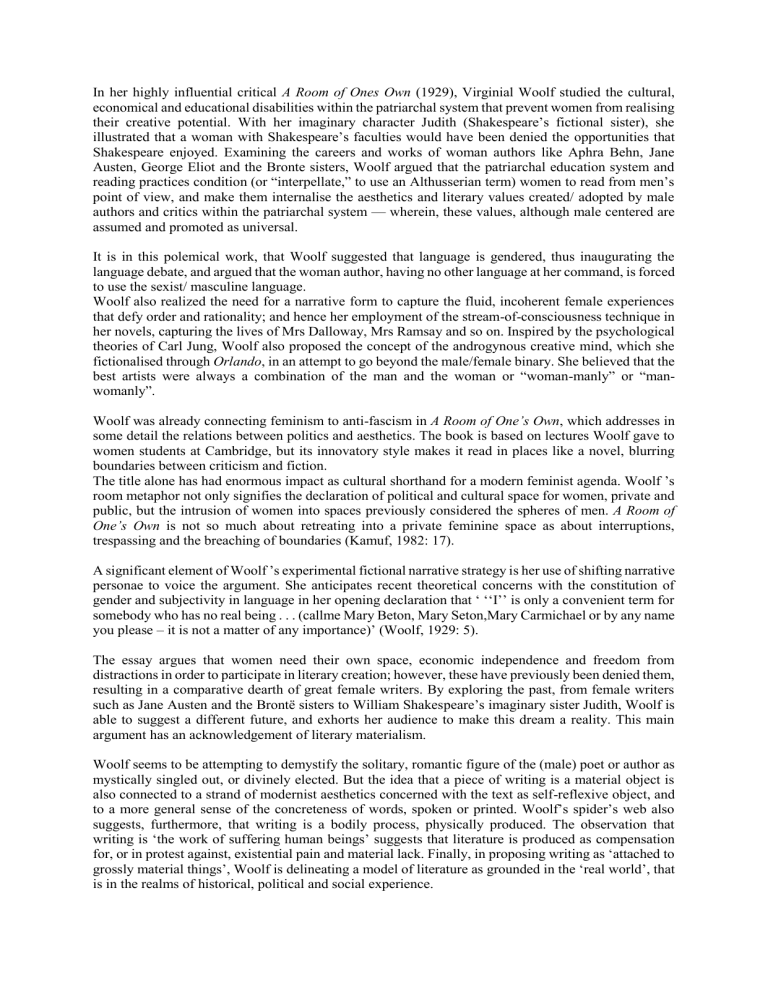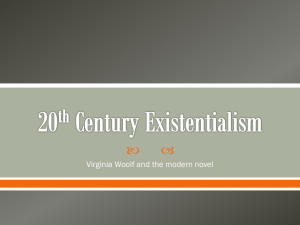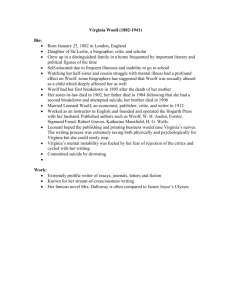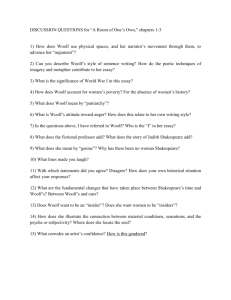
In her highly influential critical A Room of Ones Own (1929), Virginial Woolf studied the cultural, economical and educational disabilities within the patriarchal system that prevent women from realising their creative potential. With her imaginary character Judith (Shakespeare’s fictional sister), she illustrated that a woman with Shakespeare’s faculties would have been denied the opportunities that Shakespeare enjoyed. Examining the careers and works of woman authors like Aphra Behn, Jane Austen, George Eliot and the Bronte sisters, Woolf argued that the patriarchal education system and reading practices condition (or “interpellate,” to use an Althusserian term) women to read from men’s point of view, and make them internalise the aesthetics and literary values created/ adopted by male authors and critics within the patriarchal system — wherein, these values, although male centered are assumed and promoted as universal. It is in this polemical work, that Woolf suggested that language is gendered, thus inaugurating the language debate, and argued that the woman author, having no other language at her command, is forced to use the sexist/ masculine language. Woolf also realized the need for a narrative form to capture the fluid, incoherent female experiences that defy order and rationality; and hence her employment of the stream-of-consciousness technique in her novels, capturing the lives of Mrs Dalloway, Mrs Ramsay and so on. Inspired by the psychological theories of Carl Jung, Woolf also proposed the concept of the androgynous creative mind, which she fictionalised through Orlando, in an attempt to go beyond the male/female binary. She believed that the best artists were always a combination of the man and the woman or “woman-manly” or “manwomanly”. Woolf was already connecting feminism to anti-fascism in A Room of One’s Own, which addresses in some detail the relations between politics and aesthetics. The book is based on lectures Woolf gave to women students at Cambridge, but its innovatory style makes it read in places like a novel, blurring boundaries between criticism and fiction. The title alone has had enormous impact as cultural shorthand for a modern feminist agenda. Woolf ’s room metaphor not only signifies the declaration of political and cultural space for women, private and public, but the intrusion of women into spaces previously considered the spheres of men. A Room of One’s Own is not so much about retreating into a private feminine space as about interruptions, trespassing and the breaching of boundaries (Kamuf, 1982: 17). A significant element of Woolf ’s experimental fictional narrative strategy is her use of shifting narrative personae to voice the argument. She anticipates recent theoretical concerns with the constitution of gender and subjectivity in language in her opening declaration that ‘ ‘‘I’’ is only a convenient term for somebody who has no real being . . . (callme Mary Beton, Mary Seton,Mary Carmichael or by any name you please – it is not a matter of any importance)’ (Woolf, 1929: 5). The essay argues that women need their own space, economic independence and freedom from distractions in order to participate in literary creation; however, these have previously been denied them, resulting in a comparative dearth of great female writers. By exploring the past, from female writers such as Jane Austen and the Brontë sisters to William Shakespeare’s imaginary sister Judith, Woolf is able to suggest a different future, and exhorts her audience to make this dream a reality. This main argument has an acknowledgement of literary materialism. Woolf seems to be attempting to demystify the solitary, romantic figure of the (male) poet or author as mystically singled out, or divinely elected. But the idea that a piece of writing is a material object is also connected to a strand of modernist aesthetics concerned with the text as self-reflexive object, and to a more general sense of the concreteness of words, spoken or printed. Woolf’s spider’s web also suggests, furthermore, that writing is a bodily process, physically produced. The observation that writing is ‘the work of suffering human beings’ suggests that literature is produced as compensation for, or in protest against, existential pain and material lack. Finally, in proposing writing as ‘attached to grossly material things’, Woolf is delineating a model of literature as grounded in the ‘real world’, that is in the realms of historical, political and social experience.



